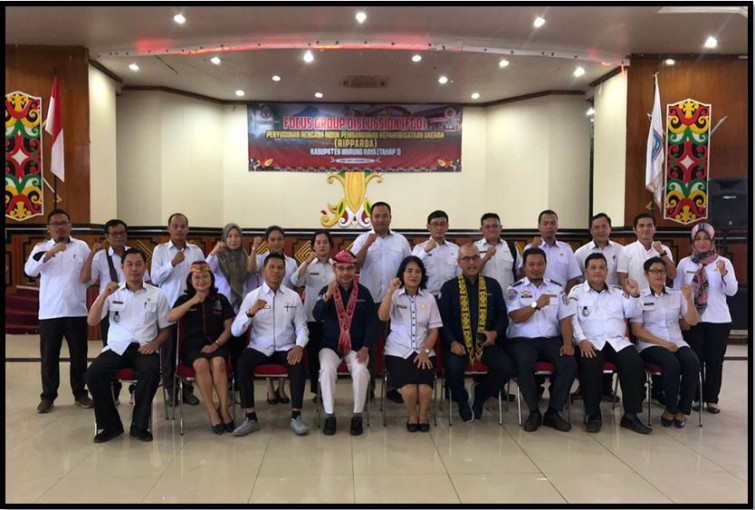
The potential in Murung Raya Regency is poised for an orchestrated crescendo, thanks to the unveiling of a Master Plan for Regional Tourism Development by the UGM Center for Tourism Studies.
The revelation unfolded during a forum group discussion (FGD) on the preparation, orchestrated in tandem with the Murung Raya Youth, Sports, and Tourism Office.
The collaborative FGD between Universitas Gadjah Mada (UGM) and the Murung Raya Regency Government marked a crucial juncture in the strategic partnership.
The event unfolded at the Murung Raya Regency Government Office in Central Kalimantan and was inaugurated by Sri Karyawati, the Head of the Youth, Sports, and Tourism Office, on Wednesday (Dec. 6).
Sri Karyawati, standing in for the Regent of Murung Raya, extended appreciation for the UGM center’s pivotal role in nurturing the region’s tourism sector. She underscored fundamental challenges that warrant attention for the holistic development of tourism in Murung Raya.
Among these challenges is the limited community awareness, particularly concerning the significance of environmental cleanliness.
Sri Karyawati acknowledged the community’s low awareness of waste management, a critical aspect in residential areas and public spaces, including tourist destinations.
“Cleanliness is the linchpin for realizing sustainable and high-quality tourism. However, fostering community awareness and a love for nature and the environment poses significant challenges,” she emphasized.
Secondly, Sri Karyawati expressed that the earnestness of the regional government in prioritizing tourism has yet to achieve optimal levels. The inadequacy of the budgetary support for tourism sector development necessitates attention.
She hoped the Murung Raya Regency Government would unveil a comprehensive concept and vision to propel tourism sector growth in the Land of Tana Malai Tolung Lingu.
“We aspire for this, recognizing the abundant potentials in this region that can generate regional income and uplift the well-being of local communities,” she added.
Dr. Destha Titi Raharjana and Wijaya from the UGM center were expert speakers at the seminar.
The event garnered participation from approximately 40 individuals, including officials from diverse agencies, district heads, local tourism communities, artists, creative economy stakeholders, and representatives from accommodation providers.
As the chair of the study team, Dr. Raharjana unveiled insights into Murung Raya Regency’s diverse ecosystems, encompassing the Muller mountain plateau, a UNESCO world heritage site in the Heart of Borneo, lowland areas, and river ecosystems.
Preliminary studies by the center found the prominence of natural tourism themes, eco-tourism, and a fusion of cultural and creative economic activities in Murung Raya’s tourism narrative.
“These thematic elements fortify Murung Raya’s identity as a tourism icon. Aligned with SDGs, the region’s tourism goals encompass economic growth (SDG 8), poverty reduction (SDG 1), eco-tourism practices mitigating climate change threats (SDG 13), and fostering partnerships (SDG 17) to position Murung Raya as a robust and competitive tourism destination,” said Dr. Raharjana.
However, disseminating information regarding tourism in Murung Raya remains a challenge. While tourism activities are underway, they have yet to attain the desired level of exposure.
Dr. Raharjana stressed the imperative of leveraging the internet for tourism marketing, emphasizing the need for an IT human resources team to optimize information dissemination about Murung Raya’s tourism potential and creative economy.
Wijaya sheds light on Murung Raya’s 84 tourist attractions, distributed across ten districts. Natural attractions constitute 61%, cultural attractions contribute 31%, and artificial attractions comprise 8%.
Notable attractions include Sanggrahan Liang Pandan Waterfall, Pasir Putih City Park, Sapan Park & Merdeka Bridge on Barito River, Bukit Tengkorak White Sand, and the Equator Monument.
Murung Raya has made strides in tourism facilities, boasting 27 hotels with 382 rooms and 511 beds, indicating a positive trajectory in tourism infrastructure.
Idontori, a Dayak cultural artist, shared insights into the rich cultural diversity of Murung Raya Regency. The region, inhabited by six indigenous ethnic groups, offers a tapestry of unique cultures ripe for development into cultural tourism attractions.
However, Idontori outlined challenges such as limited community awareness and the absence of facilities for cultural performances in studios.
“Cultural studios and their facilities are crucial to attracting young people for performance training. Currently, we manage the Sangiang Bohombit cultural studio, nurturing an interest in traditional Dayak dance among young individuals,” he added.
Pursuing Murung Raya’s potential, the Master Plan for Regional Tourism Development unfurls as a compass, guiding the trajectory toward sustainable, culturally rich, and economically empowering tourism.
Author: Agung Nugroho

